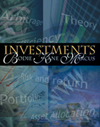Text TOC Part 1: Introduction
1. The Investment Environment
2. Markets and Instruments
3. How Securities are Traded
4. Mutual Funds and Other Investment Companies
5. History of Interest Rates and Risk Premiums Part 2: Portfolio Theory
6. Risk and Risk Aversion
7. Capital Allocation Between the Risky Asset and the Risk-Free Asset
8. Optimal Risky Portfolios Part 3: Equilibrium in Capital Markets
9. The Capital Asset Pricing Model
10. Single-Index and Multifactor Models
11. Arbitrage Pricing Theory
12. Market Efficiency
13. Empirical Evidence on Security Returns Part 4: Fixed-Income Securities
14. Bond Prices and Yields
15. The Term Structure of Interest Rates
16. Fixed-Income Portfolio Management Part 5: Security Analysis
17. Macroeconomic and Industry Analysis
18. Equity Valuation Models
19. Financial Statement Analysis Part 6: Options, Futures, and Other Derivatives
20. Options Markets: Introduction
21. Option Valuation
22. Futures Markets
23. Futures and Swaps: A Closer Look Part 7: Applied Portfolio Management
24. Portfolio Performance Evaluation
25. International Diversification
26. The Process of Portfolio Management
27. The Theory of Active Portfolio Management Appendix A. Quantitative Review Appendix B. CFA Citations Add-In Text TOC BEYOND GREED AND FEAR: Understanding Behavioral Finance and the Psychology of Investing by Hersh Shefrin (Mario L. Belotti Chair in Finance, Santa Clara University, 2002, Oxford University Press)
Part I. What is Behavioral Finance?
Ch. 1 An Introduction
Ch. 2 Heuristic-Driven Bias: The First Theme
Ch. 3 Frame Dependence: The Second Theme
Ch. 4 Inefficient markets: The Third Theme Part II. Prediction
Ch. 5 Trying to Predict the Market
Ch. 6 Sentimental Journey: The Illusion of Validity
Ch. 7 Picking Stocks to Beat the Market
Ch. 8 Biased Reactions to Earnings Announcements Part III. Individual Investors
Ch. 9 “Get-Evenitis”: Riding Losers Too Long
Ch. 10 Portfolios, Pyramids, Emotions, and Biases
Ch. 11 Retirement Saving: Myopia and Self-Control Part IV. Institutional Investors
Ch. 12 Open-Ended Mutual Funds: Misframing, “Hothands,” and Obfuscation Games
Ch. 13 Closed-End Funds: What Drives Discount?
Ch. 14 Fixed Income Securities: The Full Measure of Behavioral Phenomena
Ch. 15 The Money Management Industry: Framing Effects, Style “Diversification,” and Regret Part V. The Interface Between Corporate Finance and Investment
Ch. 16 Corporate Takeovers and the Winner’s Curse
Ch. 17 IPOs: Initial Underpricing, Long-term Underperformance, and “Hot-Issue” Markets
Ch. 18 Optimism in Analysts’ Earnings Predictions and Stock Recommendations Part VI. Options, Futures, and Foreign Exchange
Ch. 19 Options: How They’re Used, How They’re Priced, and How They Reflect Sentiment
Ch. 20 Commodity Futures: Orange Juice and Sentiment
Ch. 21 Excessive Speculation in Foreign Exchange Markets | 



 2002 McGraw-Hill Higher Education
2002 McGraw-Hill Higher Education


 2002 McGraw-Hill Higher Education
2002 McGraw-Hill Higher Education